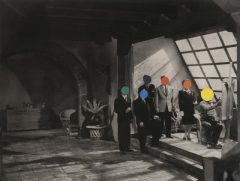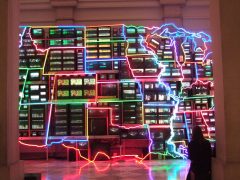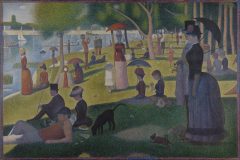TOPIC > ARTICLE
Fresh milk, Blue screens
MILK ON THE EDGE, Exonemo @ hpgrp Gallery New York
June 13, 2017(Tue)|
Article by Chris Romero

The peculiar title of Exonemo’s first solo exhibition in the United States, “Milk on the Edge”, comes from the artist duo’s first experience buying milk in New York. After purchasing the milk from a bodega, they inspected it, thinking it smelled and tasted funny. However, they were unsure if that was just how American milk tastes. When they asked their landlord about it, she tried it, exclaiming “on the edge!” The milk, in between new and rotten, became an analogy for Exonemo’s exhibition which visualizes the vague area between the real and virtual, the physical and digital. The exhibition features three series of works,
Body Paint
, EOF
, and A Sunday afternoon
. In the works, Exonemo repurposes, reimagines, and revitalizes screens as a medium for artistic commentary on our digital world. The idea of edges and frames, and what they mean to us, is also explored throughout the works.BODY PAINT (2014) / HEAVY BODY PAINT (2016)
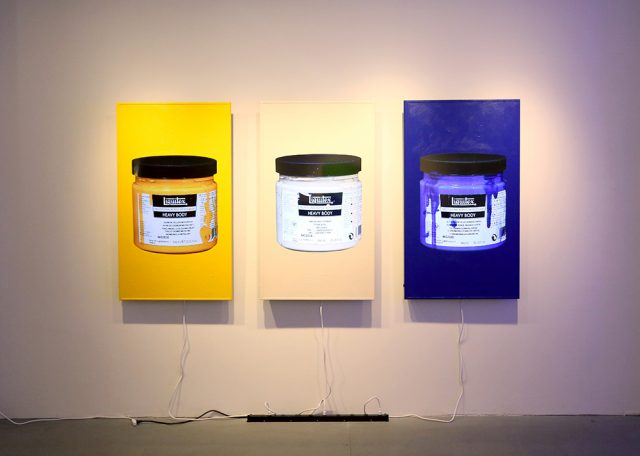
The borders between the real and virtual continue to be erased. The
Body Paint
series comments on the new territories formed by this erasure. The series consists of hand-painted LCD screens that play video of a person or object that matches the color of the painted screen. With something like sour milk, we can tell when it is bad. We know it will give us a stomach ache, so we avoid the temptation to consume it. Compared to this, we rarely question the drawbacks to our technological addictions. We plug in, ignoring the fault lines between the real and “fake”. Of course, the series is not specifically anti-technology. Rather, it is the opposite. In commenting on the subject of our physical bodies merging with the technology, Exonemo is trying to find some sort of spiritual harmony or balance between the two worlds.
The series makes me think of conceptual artist John Baldessari’s work in which he appropriates photographs and applies bright solid colors to the faces of people in the images. In that series, Baldessari shifts the focus of the viewer’s eye to the details in the image that we normally ignore. In
Body Paint
a similar effect happens through a different approach. Exonemo blots out the screen to merge the physical hardware with the moving image. The series, like Baldessari’s work, invites us to question how we see images. In Body Paint
, the screen and image come together as a painting. Our way of identifying a screen, or the content on it, and what we expect it to show, is disrupted and distorted.
201703 EOF (2017) // 201704 EOF (2017)
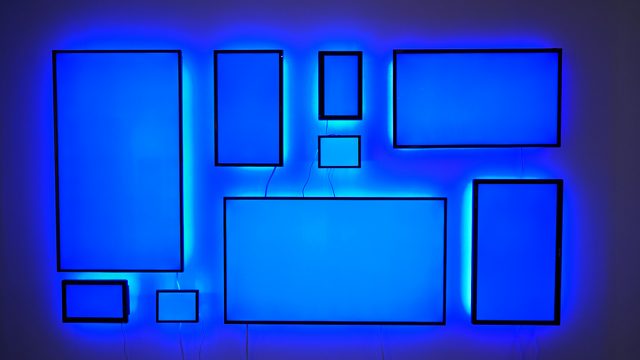
Exonemo’s newest series,
EOF
, explores the effect screens have on us from a psychological, physiological, and emotive, perspective. In the series, monitors project artificial light, the back of the screens are affixed with LED lights that project another type of light onto the wall behind the screen.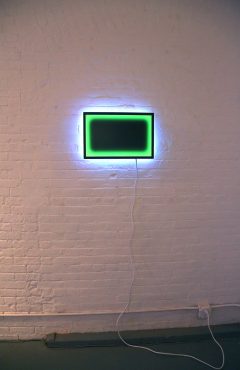 The smaller
The smaller 201703 EOF
, features changing hues of color. The light that it emits makes us focus on the frame of the screen, the thin border that separates the real and digital. Depending on which angle the work is viewed at, the light on the screen changes tonality. Thus, the light from the screen changes at our own will, while the light from the back of the screen always remains the same. This gesture begins to show the contrasting elements of EOF
. The series becomes about viewing artificially simulated light, and light projected in the physical world. The parallels are even more apparent in the larger EOF
work.
In
201704 EOF
nine screens of varying size are mounted together as a sort of assemblage. When looking at the work closely, it is possible to see that each screen emits a different shade of blue, but together they form an enveloping wall of light. The blue screen, often nicknamed “the blue screen of death” is a symbol of faulty hardware, a machine that no longer operates. Interestingly enough, scientists have also found that blue light has a calming and magnetic property to it, though it can also prove harmful to human eyes.
The piece brings to mind Nam June Paik’s historic but I think Exonemo’s message is a bit different.
EOF
is charming, but also comes with a sense of warning. If we do not keep some distance from our screens we can get lost in their light. As Exonemo described it to me, the series is more so a “No Information Superhighway”. There is only a warm glow, no memes, data, or 3D effects, but still EOF
remains incredibly hard to look away from.
A Sunday afternoon (2017)
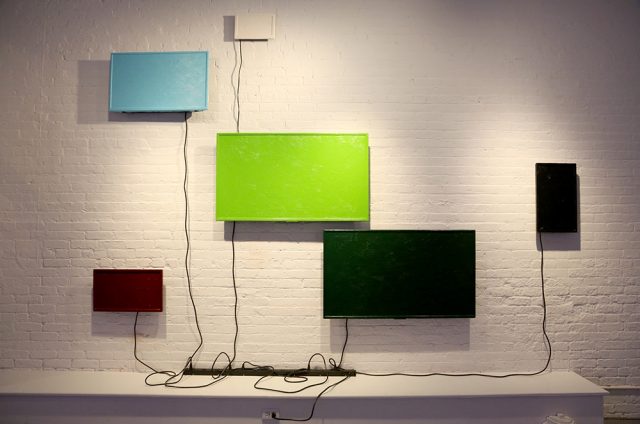
When I first saw the
A Sunday afternoon
series it reminded me of Google’s image search results. If you’re computer is slow like mine, Google will take a few seconds to load images properly. During that brief moment the image search presents content as rectangular blocks of color. A Sunday afternoon
is not exactly commenting on this occurrence, but it does comment on how we view digital images. The series features several screens of various sizes covered entirely in acrylic paint and mounted in a juxtaposition mimicking the famous painting by Georges Seurat. We often look at screens expecting them to present moving images. We expect them to be of no texture, as flat as possible, and mindlessly powered on forever. This is not the case in Exonemo’s A Sunday afternoon
.Paint is slathered onto the screens, we can see the brushwork, the various coats, the impasto of the acrylic. Oddly enough the screens are plugged in. I did not notice this until Exonemo pointed it out. When I asked if the screens were playing something they simply said, “I don’t know.” How often do we look at images and realize they are connected, plugged into a network of wires and cables in the ocean and under the earth? This borders on the same feeling of
EOF
. When we get lost in the light of our devices we fail to realize what they are capable of, and that they are rectangles mounted onto walls or nestled in our hands. In this way, Exonemo’s painting of the screens presents a sense of separation anxiety.Another element then to the work, in line with Seurat’s
A Sunday afternoon
is that of pointillism. Here, the genre of art is brought into the contemporary. Each screen serves as a pixel in the composition. The genre itself was originally meant to be a romanticization or beautification of reality, an escape from what the world really looks like. Pointillism still remains relevant today, perhaps because the pixel is still used. However, in the world of technology, it seems we attempt to use our pixels to more and more represent the real world, offering higher and higher definition, and now more sensory experiences, 3D movies, virtuality, AI companions. It’s ironic then, that exonemo’s choosing of A Sunday Afternoon
is a painting of a time where people are looking toward something in nature rather than looking down at their phones. By covering up the screens, exonemo disrupts our assumptions or anticipation of watching a screen, the work is a momentary pause on our captivation with technology.Exonemo frequently reinvents their practice. They have utilized the internet, created large-scale installations, and organized internet themed flea markets.
Milk On The Edge
comments on similar subject matter to their previous works, but a new perspective is also present. Now that the artist duo is working in the US, they are taking into consideration borders - whether they be geographical, technological, physical or metaphorical. Their perception continues to evolve, allowing their works to remain fresh and poignant to contemporary issues surrounding art and identity in relation to digital culture.
Article by Chris Romero
Info
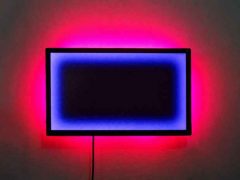 exonemo “Milk on the Edge”
exonemo “Milk on the Edge”hpgrp gallery New York
May 5th – June 10th, 2017
http://hpgrpgallery.com/
Chris Romero
Chris Romero is a curator, writer, and artist interested in contemporary art and digital culture. His objective is to create collaborative activities that disrupt rigid notions of what art is or can be. He is especially interested in working with emerging artists, producing unusual and unconventional projects, and cultivating cross-cultural exchange. From September to December he will attend a research residency in Seoul at the National Museum of Modern and Contemporary Art. He is also curating an exhibition entitled Forever Fornever, at Rhode Island College in Providence, and an online exhibition for the Wrong Biennial.
http://www.romerochris.com/
@cromeromero

